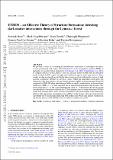ETHOS – an Effective Theory of Structure Formation: detecting dark matter interactions through the Lyman-α forest
Author(s)
Bose, Sownak; Vogelsberger, Mark; Zavala, Jesús; Pfrommer, Christoph; Cyr-Racine, Francis-Yan; Bohr, Sebastian; Bringmann, Torsten; ... Show more Show less
DownloadAccepted version (4.117Mb)
Open Access Policy
Open Access Policy
Creative Commons Attribution-Noncommercial-Share Alike
Terms of use
Metadata
Show full item recordAbstract
© 2018 The Author(s). We perform a series of cosmological hydrodynamic simulations to investigate the effects of non-gravitational dark matter (DM) interactions on the intergalactic medium (IGM). In particular, we use the ETHOS framework to compare statistics of the Lyman-α forest in cold dark matter (CDM) with an alternative model in which the DM couples strongly with a relativistic species in the early universe. These models are characterized by a cut-off in the linear power spectrum, followed by a series of 'dark acoustic oscillations' (DAOs) on subdwarf scales. While the primordial cut-off delays the formation of the first galaxies, structure builds upmore rapidly in the interacting DMmodel compared to CDM.We show that although DAOs are quickly washed away in the non-linear clustering of DM at z ≲ 10, their signature can be imprinted prominently in the Lyman-α flux power spectrum at z > 5. On scales larger than the cut-off (k∼0.08 s km-1 for the specific model considered here), the relative difference to CDM is reminiscent of a warm dark matter (WDM) model with a similar initial cut-off; however, the redshift evolution on smaller scales is distinctly different. The appearance and disappearance of DAOs in the Lyman-α flux spectrum provides a powerful way to distinguish interacting DM models from WDM and, indeed, variations in the thermal history of the IGM that may also induce a small-scale cut-off.
Date issued
2018Department
Massachusetts Institute of Technology. Department of Physics; MIT Kavli Institute for Astrophysics and Space ResearchJournal
Monthly Notices of the Royal Astronomical Society
Publisher
Oxford University Press (OUP)